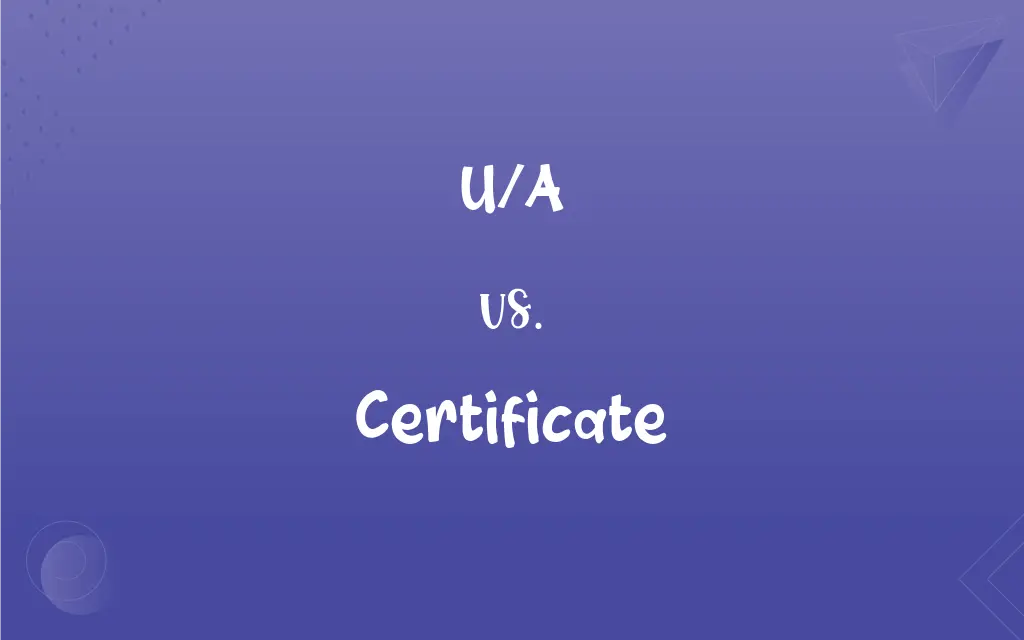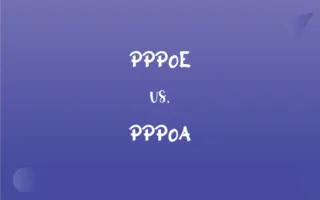U/A vs. Certificate: What's the Difference?
Edited by Aimie Carlson || By Janet White || Published on February 5, 2024
U/A is a film rating meaning parental guidance for children under 12; a certificate is an official document attesting to a status or level of achievement.

Key Differences
U/A, in the context of film classification, stands for "Unrestricted Public Exhibition - but with a word of caution that Parental discretion required for children below 12 years." This rating suggests that the content is suitable for viewers but may contain elements unsuitable for children under 12. In contrast, a certificate is a formal document attesting to a certain fact, often used to verify qualifications, authenticity, or completion of a course or training.
The U/A rating guides consumers, particularly parents, on the suitability of a film for younger audiences. It often indicates that the film may have mild violence, language, or adult themes that require parental guidance for children. On the other hand, a certificate can range from educational qualifications, such as a degree or diploma, to certificates of authenticity for products or artworks.
Film censorship boards assign the U/A rating after evaluating the content of a movie. This rating plays a crucial role in guiding audience decisions, especially for families with younger children. In contrast, certificates are issued by educational institutions, authorities, or organizations to affirm completion, authenticity, or compliance.
U/A rated films are accessible to all age groups but with the advisory note for parental guidance. This rating is a middle ground between general viewership and content suitable only for adults. Certificates, however, serve as a proof or record, often required for official, educational, or professional purposes, validating achievement or status.
U/A is a film rating indicating content suitability with parental guidance for children, whereas a certificate is a document that serves as official proof or validation in various contexts, from education to authenticity.
ADVERTISEMENT
Comparison Chart
Definition
Film rating for parental guidance
Document proving status or achievement
Purpose
To guide on film suitability
To attest qualifications, authenticity
Applicable Context
In film classification
In educational, professional, artistic settings
Target Audience
Film viewers, especially families
Individuals, authorities, institutions
Nature
Advisory rating
Formal proof or record
ADVERTISEMENT
U/A and Certificate Definitions
U/A
U/A is a film rating suggesting parental guidance.
The movie was rated U/A due to its mild action scenes.
Certificate
Certificates can authenticate products or art.
The painting came with a certificate of authenticity.
U/A
U/A indicates suitability for viewers above 12 years.
His film received a U/A rating, making it family-friendly.
Certificate
Certificates are issued by authorities or institutions.
The course completion certificate was issued by the university.
U/A
U/A denotes films with potentially sensitive content.
The U/A rated film contained some adult humor.
Certificate
Certificates validate qualifications or completion.
She obtained a certificate in digital marketing.
U/A
U/A is a middle ground in film content rating.
As a U/A film, it appealed to both teens and adults.
Certificate
Certificates serve as formal proof or record.
Her training certificate helped her get the job.
U/A
U/A guides parents about their children's viewing.
They checked the U/A rating before watching the movie with kids.
Certificate
A certificate is a document verifying an achievement.
He proudly displayed his graduation certificate.
Certificate
A document establishing the authenticity of certain details of an item, event, or transaction
A certificate of birth.
FAQs
Can children watch U/A movies?
Yes, but it's advised that they do so under adult supervision.
What does U/A mean?
U/A generally stands for "Unaccompanied/Adult." It's used to classify content suitable for adults but not for unaccompanied children.
Is U/A the same as PG-13?
U/A is similar to PG-13 in the U.S., suggesting parental guidance for children under a certain age.
In what contexts is U/A used?
U/A is primarily used in film and television classification.
Can U/A content contain violence?
Yes, but it's usually moderate and not excessively graphic.
Does U/A mean the content is educational?
Not necessarily; it's more about content suitability than educational value.
What types of certificates are there?
Various, including educational, birth, marriage, and death certificates.
Can certificates expire?
Some do, like certain professional certifications. Others, like birth certificates, do not.
Is U/A a global standard?
No, U/A is more common in certain regions, like India. Other regions have different rating systems.
Can U/A content have strong language?
Mild strong language is possible, but not excessively.
Is a certificate legally binding?
Yes, it's a formal document recognized by legal systems.
Is U/A suitable for teenagers?
Generally, yes, but it depends on the content's nature and the teenager's maturity level.
What is a digital certificate?
A digital certificate, used online, verifies the identity of a website or user.
Can anyone issue a certificate?
Official certificates must be issued by authorized bodies.
How do you obtain a certificate?
It depends on the type, but generally by meeting specific criteria or completing a process.
Are certificates valuable?
Yes, they can be critical for employment, legal identification, and personal verification.
Are U/A ratings legally enforced?
In most regions, they are advisory rather than legally binding.
What is a certificate?
A certificate is an official document attesting to a fact, like achievement, ownership, or authenticity.
How important is a certificate?
It's crucial as it serves as legal or formal proof.
What's the difference between a certificate and a degree?
A degree is awarded for completing a higher education program, while a certificate can be for various achievements or facts.
About Author
Written by
Janet WhiteJanet White has been an esteemed writer and blogger for Difference Wiki. Holding a Master's degree in Science and Medical Journalism from the prestigious Boston University, she has consistently demonstrated her expertise and passion for her field. When she's not immersed in her work, Janet relishes her time exercising, delving into a good book, and cherishing moments with friends and family.
Edited by
Aimie CarlsonAimie Carlson, holding a master's degree in English literature, is a fervent English language enthusiast. She lends her writing talents to Difference Wiki, a prominent website that specializes in comparisons, offering readers insightful analyses that both captivate and inform.






































































